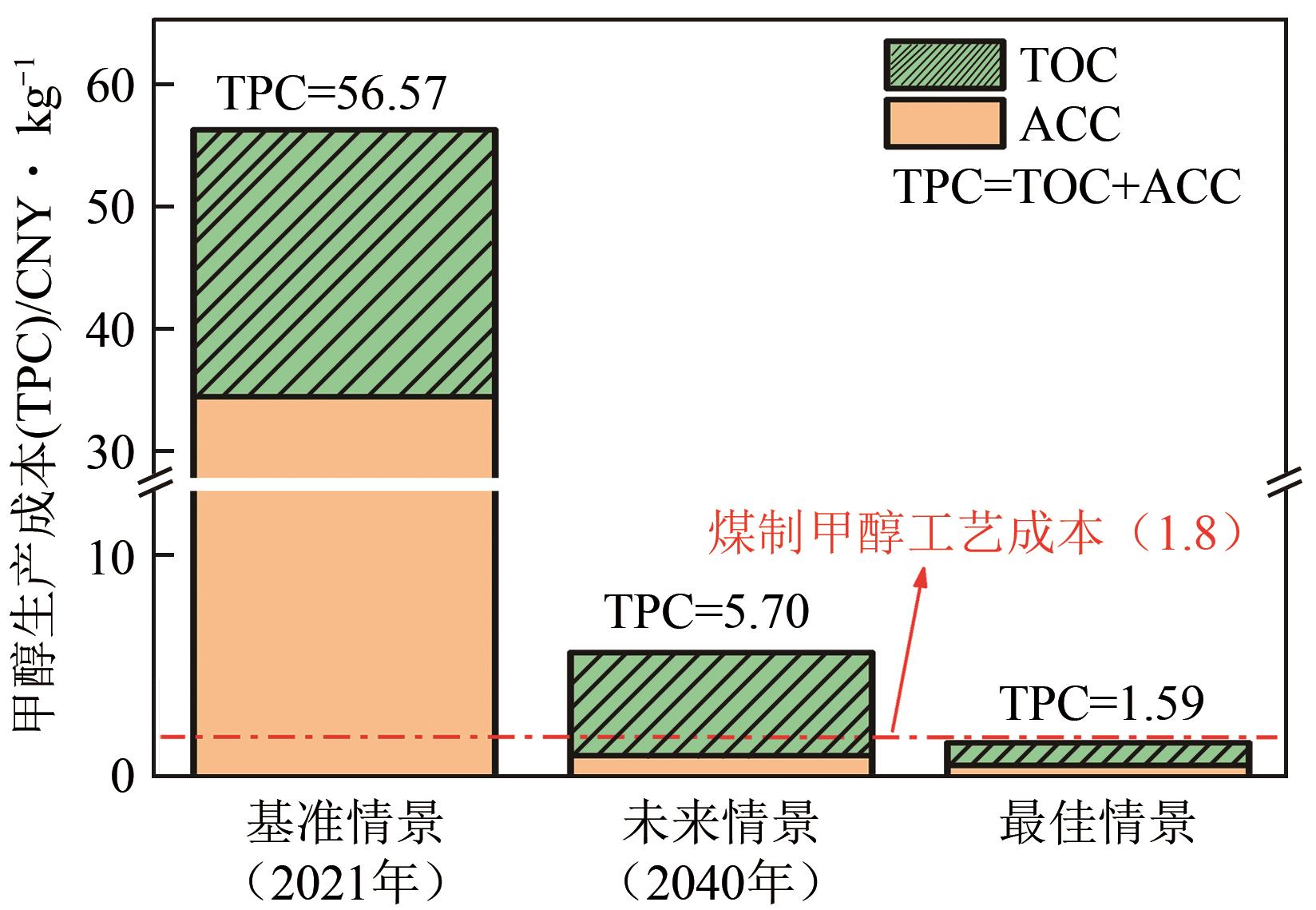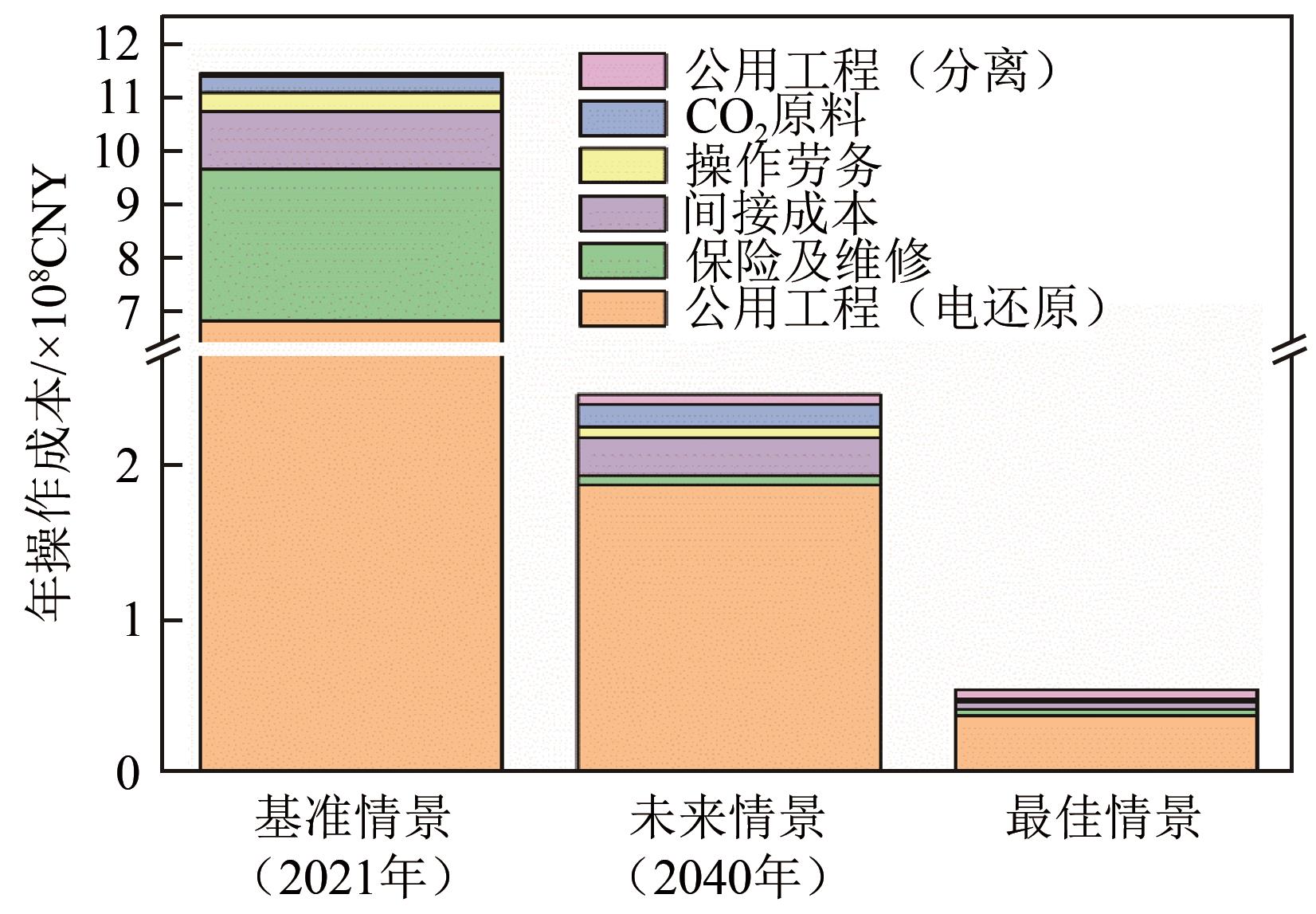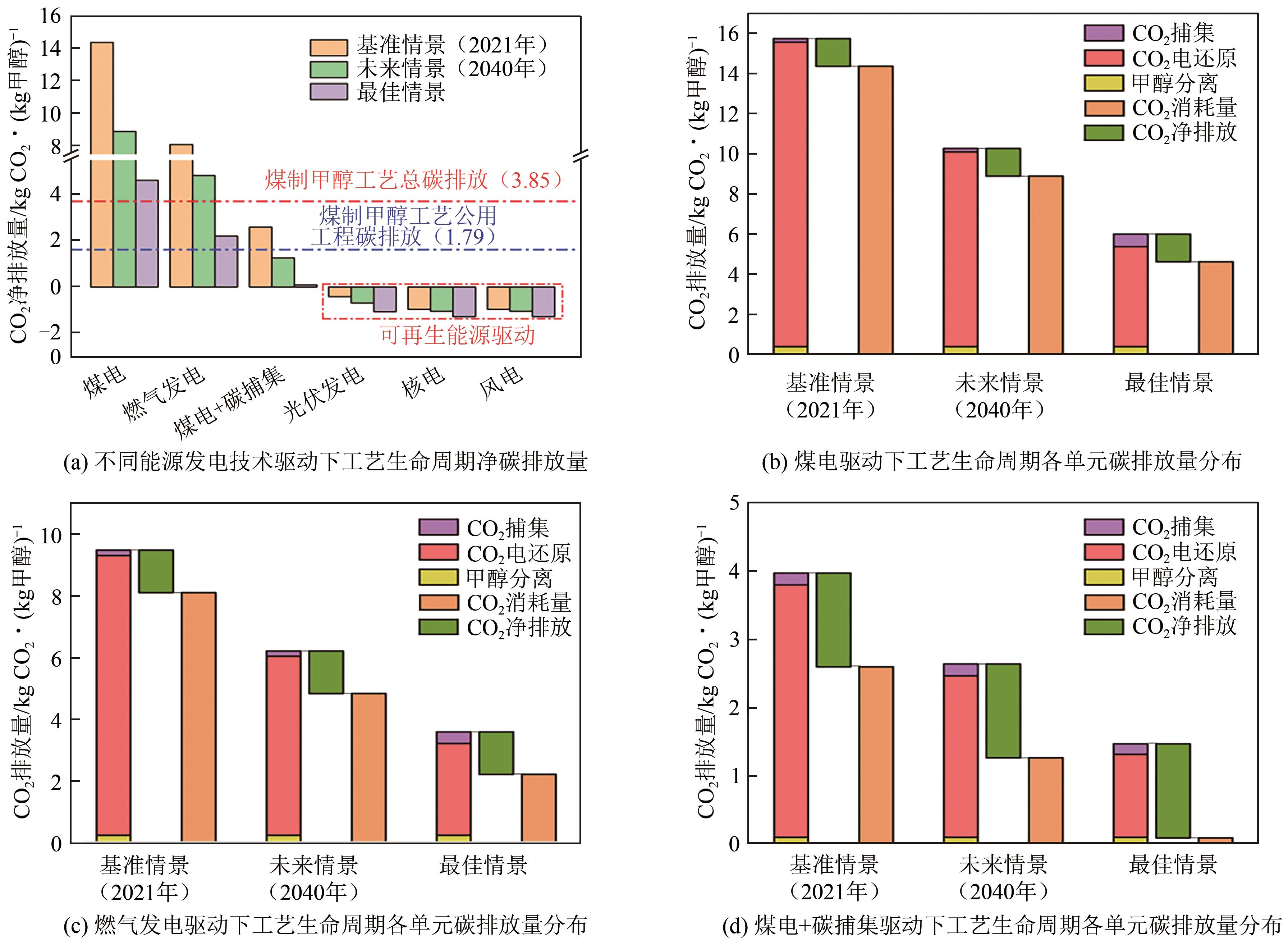化工进展 ›› 2022, Vol. 41 ›› Issue (3): 1256-1264.DOI: 10.16085/j.issn.1000-6613.2021-2226
离子液体电还原CO2合成甲醇过程评价与分析
常斐1,2( ), 詹国雄1,2, 史森森1,2, 曾少娟1,3, 张香平1,3(
), 詹国雄1,2, 史森森1,2, 曾少娟1,3, 张香平1,3( )
)
- 1.中国科学院过程工程研究所,北京 100190
2.中国科学院大学,北京 100049
3.先进能源科学与技术广东省实验室,广东 惠州 516227
-
收稿日期:2021-11-01修回日期:2021-12-25出版日期:2022-03-23发布日期:2022-03-28 -
通讯作者:张香平 -
作者简介:常斐(1990—),女,博士研究生,研究方向为系统集成及评价。E-mail:fchang@ipe.ac.cn 。 -
基金资助:国家重点研发计划(2020YFA0710200);国家自然科学基金(21838010)
Process assessment for electroreduction CO2 to methanol in ionic liquid electrolyte
CHANG Fei1,2( ), ZHAN Guoxiong1,2, SHI Sensen1,2, ZENG Shaojuan1,3, ZHANG Xiangping1,3(
), ZHAN Guoxiong1,2, SHI Sensen1,2, ZENG Shaojuan1,3, ZHANG Xiangping1,3( )
)
- 1.Institute of Process Engineering, Chinese Academy of Sciences, Beijing 100190, China
2.University of Chinese Academy of Sciences, Beijing 100049, China
3.China Advanced Energy Science and Technology Guangdong Laboratory, Huizhou 516227, Guangdong, China
-
Received:2021-11-01Revised:2021-12-25Online:2022-03-23Published:2022-03-28 -
Contact:ZHANG Xiangping
摘要:
CO2电还原合成化学品因反应条件温和、可利用分布式清洁能源等优势成为国际热点,被视为缓解全球变暖和能源危机的有效途径之一,对该类技术潜在经济及环境效益进行系统评估,可为新技术工业应用提供重要支撑。本文以离子液体电还原CO2制甲醇工艺为例,首先进行概念设计和建模,建立了基于生命周期的工艺经济性及碳排放评价模型,获得了离子液体电还原CO2制甲醇工艺的盈利前景和碳减排潜力。通过灵敏度分析,确定了例如法拉第效率、电费及槽电压等影响工艺经济性的关键技术参数。结果表明,与传统煤制甲醇工艺相比,离子液体电还原CO2制甲醇工艺兼具一定的经济效益与碳减排潜力。在最佳假设前提下,新工艺可节约成本约11.67%。若完全采用可再生能源提供电力,则可实现生命周期内的负碳排放,即每生产1kg甲醇最高可消纳1.29kg CO2。本研究为低碳合成甲醇变革性技术的研发提供了重要参考。
中图分类号:
引用本文
常斐, 詹国雄, 史森森, 曾少娟, 张香平. 离子液体电还原CO2合成甲醇过程评价与分析[J]. 化工进展, 2022, 41(3): 1256-1264.
CHANG Fei, ZHAN Guoxiong, SHI Sensen, ZENG Shaojuan, ZHANG Xiangping. Process assessment for electroreduction CO2 to methanol in ionic liquid electrolyte[J]. Chemical Industry and Engineering Progress, 2022, 41(3): 1256-1264.
| 参数 | 基准情景 (2021年) | 未来情景(2040年) | 最佳情景 |
|---|---|---|---|
| 电流密度/mA·cm-2 | 67.00 | 1500.00 | 2000.00 |
| 甲醇法拉第效率/% | 89 | 95 | 100 |
| 槽电压/V | 3.28 | 2.24 | 1.21 |
| 转化率/% | 15 | 35 | 50 |
| 催化剂负载量/mg·cm-2 | 1.00 | 1.00 | 1.00 |
| CO2原料成本/CNY·t-1 | 400 | 200 | 0 |
| 工艺水/CNY·t-1 | 4 | 4 | 4 |
| 蒸汽/CNY·t-1 | 120 | 120 | 120 |
| 电费/CNY·kWh-1 | 0.70 | 0.30 | 0.12 |
| 电解槽成本/USD·m-2 | 9690.46 | 4665.56 | 3110.37 |
表1 基于不同技术及市场假设的参数表[7,17-24]
| 参数 | 基准情景 (2021年) | 未来情景(2040年) | 最佳情景 |
|---|---|---|---|
| 电流密度/mA·cm-2 | 67.00 | 1500.00 | 2000.00 |
| 甲醇法拉第效率/% | 89 | 95 | 100 |
| 槽电压/V | 3.28 | 2.24 | 1.21 |
| 转化率/% | 15 | 35 | 50 |
| 催化剂负载量/mg·cm-2 | 1.00 | 1.00 | 1.00 |
| CO2原料成本/CNY·t-1 | 400 | 200 | 0 |
| 工艺水/CNY·t-1 | 4 | 4 | 4 |
| 蒸汽/CNY·t-1 | 120 | 120 | 120 |
| 电费/CNY·kWh-1 | 0.70 | 0.30 | 0.12 |
| 电解槽成本/USD·m-2 | 9690.46 | 4665.56 | 3110.37 |
| 费用组成 | 参考对象 |
|---|---|
| 年度生产总成本(TPC) | 年度投资成本(ACC),年度操作费用(TOC) |
| 年度投资成本(ACC) | 总投资成本(TCC) |
| 总投资成本(TCC) | 固定投资成本(FCC),流动资本,开车准备支出(溶剂,催化剂等) |
| 固定投资成本(FCC) | 直接投资(DC),间接投资(IC) |
| 直接投资(DC),间接投资(IC) | 总设备成本(PEC) |
| 年度操作费用(TOC) | 可变操作费用(VOC),固定操作费用(FOC) |
表2 甲醇年度生产总成本计算方法[12,25]
| 费用组成 | 参考对象 |
|---|---|
| 年度生产总成本(TPC) | 年度投资成本(ACC),年度操作费用(TOC) |
| 年度投资成本(ACC) | 总投资成本(TCC) |
| 总投资成本(TCC) | 固定投资成本(FCC),流动资本,开车准备支出(溶剂,催化剂等) |
| 固定投资成本(FCC) | 直接投资(DC),间接投资(IC) |
| 直接投资(DC),间接投资(IC) | 总设备成本(PEC) |
| 年度操作费用(TOC) | 可变操作费用(VOC),固定操作费用(FOC) |
| 费用组成 | 参考对象 | 比例/% |
|---|---|---|
| 电解槽直接投资(DCER) | ||
| 电解槽设备 | 电解槽设备 | 100 |
| 电解槽配套设备 | 电解槽设备 | 180 |
| 电解槽安装费用 | 电解槽设备 | 34 |
| 分离设备直接投资(DCSEP) | — | — |
| 间接投资(IC) | ||
| 意外支出 | 直接投资(DCER,DCSEP) | 15 |
| 建设费用 | 直接投资(DCER,DCSEP) | 8 |
| 代理费用 | 直接投资(DCER,DCSEP) | 5 |
| 工程监管 | 直接投资(DCER,DCSEP) | 8 |
| 流动资本 | 固定投资成本(DCER,DCSEP,IC) | 15 |
| 开车准备支出 | ||
| 溶剂成本 | 溶剂单价×总装填量 | — |
| 催化剂成本 | 催化剂单价×用量 | — |
| 生产准备 | 原料单价×用量+电费×能耗 | — |
| 总投资成本(TCC) | 上述费用总和 | |
表3 总投资费用的计算方法[12,25]
| 费用组成 | 参考对象 | 比例/% |
|---|---|---|
| 电解槽直接投资(DCER) | ||
| 电解槽设备 | 电解槽设备 | 100 |
| 电解槽配套设备 | 电解槽设备 | 180 |
| 电解槽安装费用 | 电解槽设备 | 34 |
| 分离设备直接投资(DCSEP) | — | — |
| 间接投资(IC) | ||
| 意外支出 | 直接投资(DCER,DCSEP) | 15 |
| 建设费用 | 直接投资(DCER,DCSEP) | 8 |
| 代理费用 | 直接投资(DCER,DCSEP) | 5 |
| 工程监管 | 直接投资(DCER,DCSEP) | 8 |
| 流动资本 | 固定投资成本(DCER,DCSEP,IC) | 15 |
| 开车准备支出 | ||
| 溶剂成本 | 溶剂单价×总装填量 | — |
| 催化剂成本 | 催化剂单价×用量 | — |
| 生产准备 | 原料单价×用量+电费×能耗 | — |
| 总投资成本(TCC) | 上述费用总和 | |
| 项目 | 基准物 | Sr/kg·h-1 | sf | 基准投入 |
|---|---|---|---|---|
| 精馏提纯单元设备投资(DCSEP) | 进料量 | 20940.23 | 0.65 | 613×104USD |
| 精馏提纯单元能耗(ESEP) | 进料量 | 20940.23 | 1 | 4.53MW |
表4 甲醇提纯精馏设备投资和能耗基础数据[27]
| 项目 | 基准物 | Sr/kg·h-1 | sf | 基准投入 |
|---|---|---|---|---|
| 精馏提纯单元设备投资(DCSEP) | 进料量 | 20940.23 | 0.65 | 613×104USD |
| 精馏提纯单元能耗(ESEP) | 进料量 | 20940.23 | 1 | 4.53MW |
| 费用组成 | 参考对象 | 比例/% |
|---|---|---|
| 可变操作费用(VOC) | ||
| CO2原料补充 | 原料单价×用量 | — |
| 溶剂补充 | 溶剂单价×年消耗量 | 2 |
| 工艺水补充 | 原料单价×用量 | — |
| 公用工程 | 电费×能耗+蒸汽单价×蒸汽用量 | — |
| 固定操作费用(FOC) | ||
| 保险支出 | 固定投资成本(FCC) | 1 |
| 维修护理 | 固定投资成本(FCC) | 1 |
| 操作劳务 | 总操作费用(TOC) | 3 |
| 市场营销 | 总操作费用(TOC) | 2 |
| 研究费用 | 总操作费用(TOC) | 5 |
| 工厂监管 | 操作劳务 | 20 |
| 间接费用 | 操作劳务 | 50 |
| 行政费用 | 操作劳务 | 25 |
| 总操作费用(TOC) | 上述费用总和 | |
表5 总操作费用的计算方法[12,16,25]
| 费用组成 | 参考对象 | 比例/% |
|---|---|---|
| 可变操作费用(VOC) | ||
| CO2原料补充 | 原料单价×用量 | — |
| 溶剂补充 | 溶剂单价×年消耗量 | 2 |
| 工艺水补充 | 原料单价×用量 | — |
| 公用工程 | 电费×能耗+蒸汽单价×蒸汽用量 | — |
| 固定操作费用(FOC) | ||
| 保险支出 | 固定投资成本(FCC) | 1 |
| 维修护理 | 固定投资成本(FCC) | 1 |
| 操作劳务 | 总操作费用(TOC) | 3 |
| 市场营销 | 总操作费用(TOC) | 2 |
| 研究费用 | 总操作费用(TOC) | 5 |
| 工厂监管 | 操作劳务 | 20 |
| 间接费用 | 操作劳务 | 50 |
| 行政费用 | 操作劳务 | 25 |
| 总操作费用(TOC) | 上述费用总和 | |
| 发电技术 | 碳排放当量/g CO2·kWh-1 |
|---|---|
| 煤电 | 820 |
| 核电 | 12 |
| 风电 | 12 |
| 光伏发电 | 41 |
| 煤电+碳捕集 | 200 |
| 燃气发电 | 490 |
表6 不同发电技术碳排放当量[5,30]
| 发电技术 | 碳排放当量/g CO2·kWh-1 |
|---|---|
| 煤电 | 820 |
| 核电 | 12 |
| 风电 | 12 |
| 光伏发电 | 41 |
| 煤电+碳捕集 | 200 |
| 燃气发电 | 490 |
| 参数 | 下限 | 基准值 | 上限 |
|---|---|---|---|
| 电流密度/mA·cm-2 | 1200 | 1500 | 1800 |
| 甲醇法拉第效率/% | 76 | 95 | 100 |
| 槽电压/V | 2.69 | 2.24 | 1.79 |
| 甲醇产量/t·d-1 | 120 | 150 | 180 |
| 转化率/% | 28 | 35 | 42 |
| CO2原料成本/CNY·t-1 | 240 | 200 | 160 |
| 电费/CNY·kWh-1 | 0.36 | 0.30 | 0.24 |
| 电解槽成本/USD·m-2 | 5598.67 | 4665.56 | 3732.45 |
| 离子液体溶剂成本/USD·t-1 | 3960 | 3300 | 2640 |
表7 未来情景(2040年)下敏感性分析中的参数及阈值
| 参数 | 下限 | 基准值 | 上限 |
|---|---|---|---|
| 电流密度/mA·cm-2 | 1200 | 1500 | 1800 |
| 甲醇法拉第效率/% | 76 | 95 | 100 |
| 槽电压/V | 2.69 | 2.24 | 1.79 |
| 甲醇产量/t·d-1 | 120 | 150 | 180 |
| 转化率/% | 28 | 35 | 42 |
| CO2原料成本/CNY·t-1 | 240 | 200 | 160 |
| 电费/CNY·kWh-1 | 0.36 | 0.30 | 0.24 |
| 电解槽成本/USD·m-2 | 5598.67 | 4665.56 | 3732.45 |
| 离子液体溶剂成本/USD·t-1 | 3960 | 3300 | 2640 |
| 1 | 苏文礼, 范煜. 金属基材料电催化CO2还原的研究进展[J]. 化工进展, 2021, 40(3): 1384-1394. |
| SU Wenli, FAN Yu. Progress of electrocatalytic reduction of CO2 on metal-based materials[J]. Chemical Industry and Engineering Progress, 2021, 40(3): 1384-1394. | |
| 2 | ADNAN M A, KIBRIA M G. Comparative techno-economic and life-cycle assessment of power-to-methanol synthesis pathways[J]. Applied Energy, 2020, 278: 115614. |
| 3 | ORELLA M J, BROWN S M, LEONARD M E, et al. A general technoeconomic model for evaluating emerging electrolytic processes[J]. Energy Technology, 2020, 8(11): 1900994. |
| 4 | DE LUNA P, HAHN C, HIGGINS D, et al. What would it take for renewably powered electrosynthesis to displace petrochemical processes?[J]. Science, 2019, 364(6438): eaav3506. |
| 5 | JOUNY M, LUC W, JIAO F. General techno-economic analysis of CO2 electrolysis systems[J]. Industrial & Engineering Chemistry Research, 2018, 57(6): 2165-2177. |
| 6 | NA J, SEO B, KIM J, et al. General technoeconomic analysis for electrochemical coproduction coupling carbon dioxide reduction with organic oxidation[J]. Nature Communications, 2019, 10: 5193. |
| 7 | GUO W W, LIU S J, TAN X X, et al. Highly efficient CO2 electroreduction to methanol through atomically dispersed Sn coupled with defective CuO catalysts[J]. Angewandte Chemie International Edition, 2021, 60(40): 21979-21987. |
| 8 | LU L, SUN X F, MA J, et al. Highly efficient electroreduction of CO2 to methanol on palladium-copper bimetallic aerogels[J]. Angewandte Chemie, 2018, 130(43): 14345-14349. |
| 9 | SUN X F, ZHU Q G, KANG X C, et al. Molybdenum-bismuth bimetallic chalcogenide nanosheets for highly efficient electrocatalytic reduction of carbon dioxide to methanol[J]. Angewandte Chemie International Edition, 2016, 55(23): 6771-6775. |
| 10 | 冯建朋, 张香平, 尚大伟, 等. 离子液体中电化学还原CO2研究评述与展望[J]. 化工学报, 2018, 69(1): 69-75. |
| FENG Jianpeng, ZHANG Xiangping, SHANG Dawei, et al. Review and prospect of CO2 electro-reduction in ionic liquids[J]. CIESC Journal, 2018, 69(1): 69-75. | |
| 11 | 江重阳, 冯佳奇, 曾少娟, 等. CO2电化学还原过程中电解质研究现状及趋势[J]. 科学通报, 2021, 66(7): 716-727. |
| JIANG Chongyang, FENG Jiaqi, ZENG Shaojuan, et al. Research status and trend of electrolytes in the CO2 electrochemical reduction[J]. Chinese Science Bulletin, 2021, 66(7): 716-727. | |
| 12 | CHANG F, ZHAN G X, WU Z X, et al. Technoeconomic analysis and process design for CO2 electroreduction to CO in ionic liquid electrolyte[J]. ACS Sustainable Chemistry & Engineering, 2021, 9(27): 9045-9052. |
| 13 | MEUNIER N, CHAUVY R, MOUHOUBI S, et al. Alternative production of methanol from industrial CO2 [J]. Renewable Energy, 2020, 146: 1192-1203. |
| 14 | BAINS P, PSARRAS P, WILCOX J. CO2 capture from the industry sector[J]. Progress in Energy and Combustion Science, 2017, 63: 146-172. |
| 15 | LEUNG D Y C, CARAMANNA G, MAROTO-VALER M M. An overview of current status of carbon dioxide capture and storage technologies[J]. Renewable and Sustainable Energy Reviews, 2014, 39: 426-443. |
| 16 | PAULILLO A, PUCCIARELLI M, GRIMALDI F, et al. The life-cycle environmental performance of producing formate via electrochemical reduction of CO2 in ionic liquid[J]. Green Chemistry, 2021, 23(17): 6639-6651. |
| 17 | HUANG Z, GRIM R G, SCHAIDLE J A, et al. The economic outlook for converting CO2 and electrons to molecules[J]. Energy & Environmental Science, 2021, 14(7): 3664-3678. |
| 18 | 何泽兴, 史成香, 陈志超, 等. 质子交换膜电解水制氢技术的发展现状及展望[J]. 化工进展, 2021, 40(9): 4762-4773. |
| HE Zexing, SHI Chengxiang, CHEN Zhichao, et al. Development status and prospects of proton exchange membrane water electrolysis[J]. Chemical Industry and Engineering Progress, 2021, 40(9): 4762-4773. | |
| 19 | 李冰玉, 毛庆, 赵健, 等. 二氧化碳电化学还原反应器的研究进展[J]. 化工进展, 2019, 38(11): 4901-4910. |
| LI Bingyu, MAO Qing, ZHAO Jian, et al. Research progress in CO2 electroreduction reactor[J]. Chemical Industry and Engineering Progress, 2019, 38(11): 4901-4910. | |
| 20 | 杨博龙, 韩清, 向中华. 质子交换膜燃料电池膜电极结构与设计研究进展[J]. 化工进展, 2021, 40(9): 4882-4893. |
| YANG Bolong, HAN Qing, XIANG Zhonghua. Progress of membrane electrode structure and its design for proton exchange membrane fuel cell[J]. Chemical Industry and Engineering Progress, 2021, 40(9): 4882-4893. | |
| 21 | AINSCOUGH C, PETERSON D, MILLER E, et al. DOE hydrogen and fuel cells program record[R]. DOE: NREL, 2014. |
| 22 | JAMES B, COLELLA W, MOTON J, et al. PEM electrolysis H2A production case study documentation[R]. Office of Scientific and Technical Information (OSTI), 2013. |
| 23 | PETERSON D, VICKERS J, DE S. DOE hydrogen and fuel cells program record: Hydrogen production cost from PEM electrolysis[R]. DOE: NREL, 2019. |
| 24 | VERMA S, LU S, KENIS P J A. Co-electrolysis of CO2 and glycerol as a pathway to carbon chemicals with improved technoeconomics due to low electricity consumption[J]. Nature Energy, 2019, 4(6): 466-474. |
| 25 | HUANG Y, ZHANG X P, ZHANG X, et al. Thermodynamic modeling and assessment of ionic liquid-based CO2 capture processes[J]. Industrial & Engineering Chemistry Research, 2014, 53(29): 11805-11817. |
| 26 | SCOTT J. The CE plant cost index: an update[J]. Chemical Engineering, 2018, 125(4): 76-77. |
| 27 | SPURGEON J M, KUMAR B. A comparative technoeconomic analysis of pathways for commercial electrochemical CO2 reduction to liquid products[J]. Energy & Environmental Science, 2018, 11(6): 1536-1551. |
| 28 | ASSEN N VON DER, JUNG J, BARDOW A. Life-cycle assessment of carbon dioxide capture and utilization: avoiding the pitfalls[J]. Energy & Environmental Science, 2013, 6(9): 2721. |
| 29 | ASSEN N VON DER, VOLL P, PETERS M, et al. Life cycle assessment of CO2 capture and utilization: a tutorial review[J]. Chemical Society Reviews, 2014, 43(23): 7982-7994. |
| 30 | STAFFELL I. Measuring the progress and impacts of decarbonising British electricity[J]. Energy Policy, 2017, 102: 463-475. |
| 31 | DAVID J, HERZOT H. The cost of carbon capture[C]//WILLIAMS D J, DURIE R A, MCMULLAN P, et al. Proc. 5th International Conference on Greenhouse Gas Control Technologies. Australia: CSIRO, 2001: 985-990. |
| 32 | AHMED U. Techno-economic feasibility of methanol synthesis using dual fuel system in a parallel process design configuration with control on green house gas emissions[J]. International Journal of Hydrogen Energy, 2020, 45(11): 6278-6290. |
| 33 | 张媛媛, 王永刚, 田亚峻. 典型现代煤化工过程的二氧化碳排放比较[J]. 化工进展, 2016, 35(12): 4060-4064. |
| ZHANG Yuanyuan, WANG Yonggang, TIAN Yajun. Comparative studies on carbon dioxide emissions of typical modern coal chemical processes[J]. Chemical Industry and Engineering Progress, 2016, 35(12): 4060-4064. |
| [1] | 张明焱, 刘燕, 张雪婷, 刘亚科, 李从举, 张秀玲. 非贵金属双功能催化剂在锌空气电池研究进展[J]. 化工进展, 2023, 42(S1): 276-286. |
| [2] | 时永兴, 林刚, 孙晓航, 蒋韦庚, 乔大伟, 颜彬航. 二氧化碳加氢制甲醇过程中铜基催化剂活性位点研究进展[J]. 化工进展, 2023, 42(S1): 287-298. |
| [3] | 郑谦, 官修帅, 靳山彪, 张长明, 张小超. 铈锆固溶体Ce0.25Zr0.75O2光热协同催化CO2与甲醇合成DMC[J]. 化工进展, 2023, 42(S1): 319-327. |
| [4] | 胡喜, 王明珊, 李恩智, 黄思鸣, 陈俊臣, 郭秉淑, 于博, 马志远, 李星. 二硫化钨复合材料制备与储钠性能研究进展[J]. 化工进展, 2023, 42(S1): 344-355. |
| [5] | 戴欢涛, 曹苓玉, 游新秀, 徐浩亮, 汪涛, 项玮, 张学杨. 木质素浸渍柚子皮生物炭吸附CO2特性[J]. 化工进展, 2023, 42(S1): 356-363. |
| [6] | 张杰, 白忠波, 冯宝鑫, 彭肖林, 任伟伟, 张菁丽, 刘二勇. PEG及其复合添加剂对电解铜箔后处理的影响[J]. 化工进展, 2023, 42(S1): 374-381. |
| [7] | 许家珩, 李永胜, 罗春欢, 苏庆泉. 甲醇水蒸气重整工艺的优化[J]. 化工进展, 2023, 42(S1): 41-46. |
| [8] | 张凤岐, 崔成东, 鲍学伟, 朱炜玄, 董宏光. 胺液吸收-分步解吸脱硫工艺的设计与评价[J]. 化工进展, 2023, 42(S1): 518-528. |
| [9] | 孙玉玉, 蔡鑫磊, 汤吉海, 黄晶晶, 黄益平, 刘杰. 反应精馏合成甲基丙烯酸甲酯工艺优化及节能[J]. 化工进展, 2023, 42(S1): 56-63. |
| [10] | 杨寒月, 孔令真, 陈家庆, 孙欢, 宋家恺, 王思诚, 孔标. 微气泡型下向流管式气液接触器脱碳性能[J]. 化工进展, 2023, 42(S1): 197-204. |
| [11] | 徐晨阳, 都健, 张磊. 基于图神经网络的化学反应优劣评价[J]. 化工进展, 2023, 42(S1): 205-212. |
| [12] | 王胜岩, 邓帅, 赵睿恺. 变电吸附二氧化碳捕集技术研究进展[J]. 化工进展, 2023, 42(S1): 233-245. |
| [13] | 舒斌, 陈建宏, 熊健, 吴其荣, 喻江涛, 杨平. 碳中和目标下推动绿色甲醇发展的必要性分析[J]. 化工进展, 2023, 42(9): 4471-4478. |
| [14] | 陈林, 徐培渊, 张晓慧, 陈杰, 徐振军, 陈嘉祥, 密晓光, 冯永昌, 梅德清. 液化天然气绕管式换热器壳侧混合工质流动及传热特性[J]. 化工进展, 2023, 42(9): 4496-4503. |
| [15] | 张帆, 陶少辉, 陈玉石, 项曙光. 基于改进恒热传输模型的精馏模拟初始化[J]. 化工进展, 2023, 42(9): 4550-4558. |
| 阅读次数 | ||||||
|
全文 |
|
|||||
|
摘要 |
|
|||||





